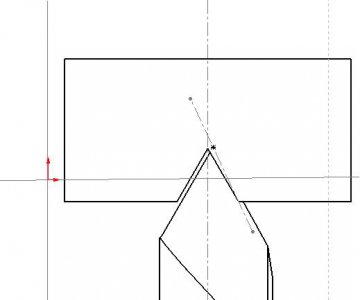- Joined
- Apr 23, 2011
- Messages
- 2,476
...So now what is the magic number 60.5 or 59.5 and what is the difference in why you would use either/or?
Schemer, if you are going to use the compound for threading then you need 29.5 or 60.5. Using 59.5 would be the equivalent of 30.5
The reasoning is here...
The relationship of movement established by having the compound set at 29.5*. The tool form does establish the thread profile, but by having the tool cut progress at not quite 30* it takes the majority of the cut on the left (leading) edge, and the right, (trailing) edge takes very light cuts. In the pic the V cut by the tool form is 60* but as can be seen by the dashed line the movement of the tool when set at less than 30* causes it to move in a marginal amount as well as left a greater amount. Causing the tool to take a heavier cut on the leading edge and a very fine cut on the trailing edge.
As the sketch illustrates, having the tool move in at an angle less than 30* we do maintain the included angle of the form tool it just cuts less on the trailing edge. If the angle is set at or greater than 30* then the tool will only cut on the leading edge as it is sliding along or moving away from the trailing edge as it cuts progressively deeper, and this will result in a staircase effect on the trailing edge.
The point of it is to eliminate the staircase effect and reduce tool loading. The drastic and perceivable difference of leaving the staircase effect is that the right thread flank in most cases is the load bearing side of the thread and needs to be as smooth and accurate as possible.
Cheers Phil

Last edited:

